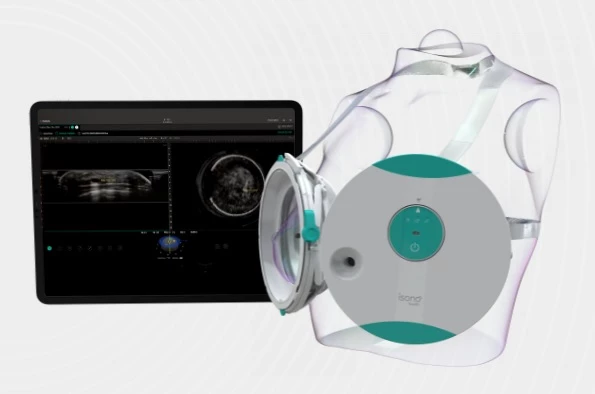“Smart” Bra as a Helper in Breast Cancer Detection
Malignant breast tumors represent one of the most common oncological diseases in women worldwide. For improving patient prognosis, it is crucial to detect the disease in its early, curable stages. In the United States, a bra is currently being tested within screening programs that performs a thorough ultrasound examination of breast glands within minutes, including 3D reconstruction and assistance in differential diagnosis based on machine learning.
Behind it All, There's a Woman
In the United States, about 1 in 8 women develop a malignant breast tumor during their lifetime. The situation is similar in the Czech Republic, where breast malignancies are the most common oncological disease in women and their incidence continues to rise.
Screening uses mammography, but it has limited sensitivity in dense breast tissue. In the USA, dense breast tissue is observed in about half of women. For women with dense breast tissue, an ultrasound examination is more suitable as it increases the chances of detecting breast malignancy in its early stages.
Two American engineers personally experienced the shortcomings of mammographic screening. They decided to join forces and in 2016 founded iSono Health, with the aim of developing technology to enhance early detection of breast malignancies, thereby improving patient prognosis. This led to the creation of the “smart” bra named ATUSA.
Ultrasound in a Bra
The ATUSA imaging system is a fully automated portable 3D breast ultrasound. The examination principle is quite simple. The patient first wears an “apparatus” similar to a bra with cups, into which the portable ultrasound device is inserted. The examination takes place lying on a bed; the health worker adjusts the position of the breasts in the cups, applies ultrasound gel, and inserts the circular portable ultrasound into the cups. Then, with a press of the start button, the device performs an automatic examination of the entire breast volume. The entire procedure takes about a minute per breast, making the total examination time around 2 minutes.
The device transmits the examined data to a computer application, which, in addition to real-time 2D visualization, also handles advanced 3D visualization and localization of any pathological focus. The primary advantage is the examination time, which is approximately 10-15 times faster than standard ultrasound examinations. The examination is standardized, reproducible, and thanks to integrated machine learning, it helps health workers in making decisions regarding the differential diagnosis of displayed lesions. Another advantage is that the examination can be performed by a health worker without breast sonography experience; only training in interpreting ultrasound findings is needed.
Ongoing Testing
The device is designed for use in outpatient settings as well as in healthcare facilities specializing in breast disease diagnostics and treatment. The Food and Drug Administration (FDA) in the United States has approved further testing of the device, which could lead to its implementation in clinical practice. The creators hope the device will not only improve cancer diagnosis in younger women with dense breast tissue but also be used in areas with limited access to mammography and general healthcare, such as in developing countries. We now eagerly await further testing results, which will be crucial for the device’s future and the prognosis of women worldwide.
(holi)
Sources:
1. Schroeder M. FDA clears wearable 3D ultrasound for breast imaging. MedCity News, 2022 May 3. Available at: https://medcitynews.com/2022/05/fda-clears-wearable-3d-breast-ultrasound-for-cancer-screening
2. Say hello to ATUSA: the world's first AI-driven portable and automated 3D breast ultrasound scanner. iSono Health, 2022. Available at: https://isonohealth.com
Did you like this article? Would you like to comment on it? Write to us. We are interested in your opinion. We will not publish it, but we will gladly answer you.
News from the world of medicine
All conferences
Popular this week
- How Compassion Fatigue Threatens Doctors and Other Healthcare Workers
- A device the size of a matchbox will help treat obstructive sleep apnea
- Good, Bad, or Ugly? What's the Deal with Eggs?
- Non-Invasive Analysis of Gut Microbiome Biomarkers Enhances Diagnosis of IBD
- New Technology Enables Early Monitoring and Therapy for tPA-Resistant Blood Clots

